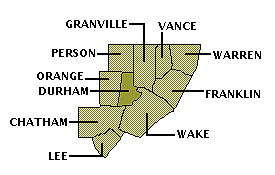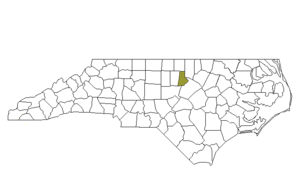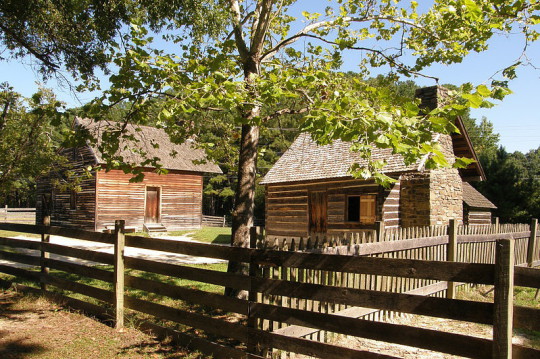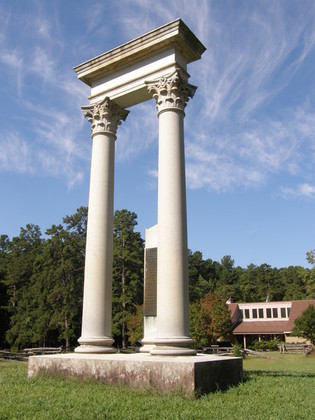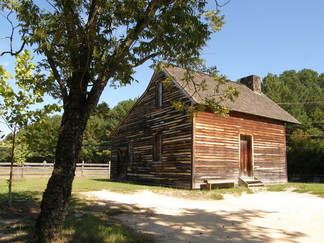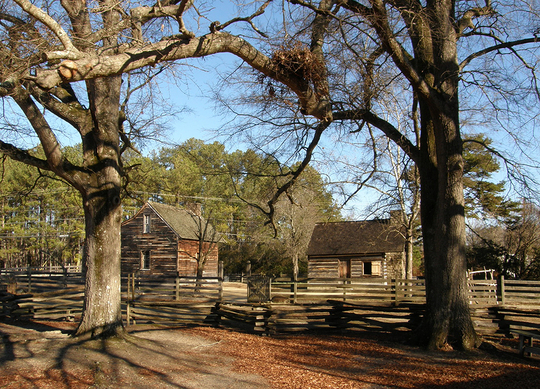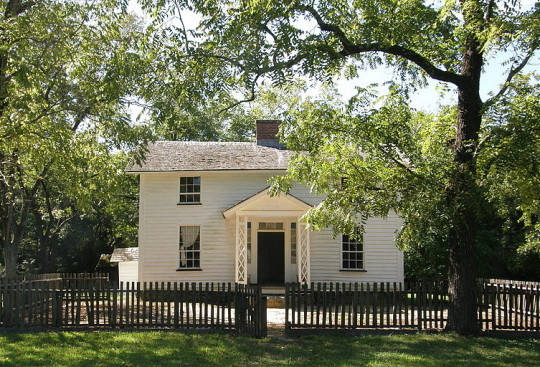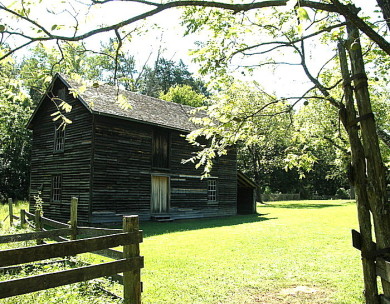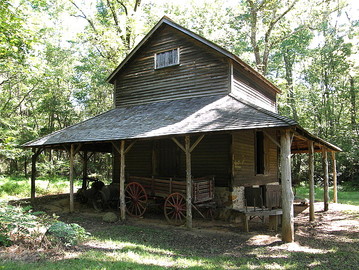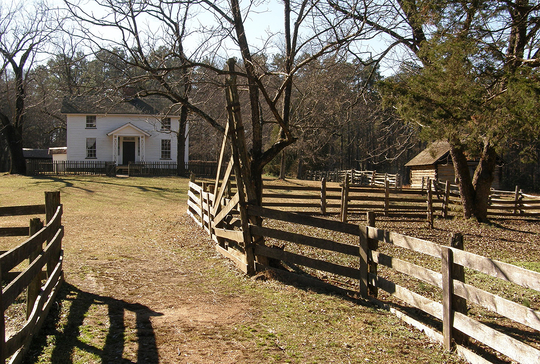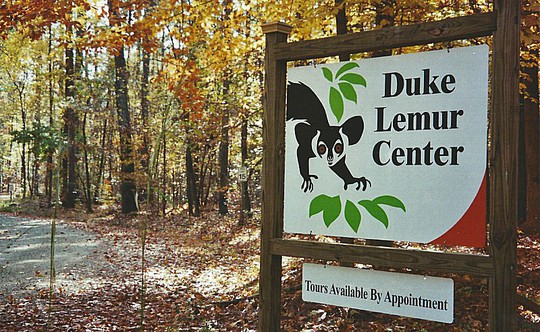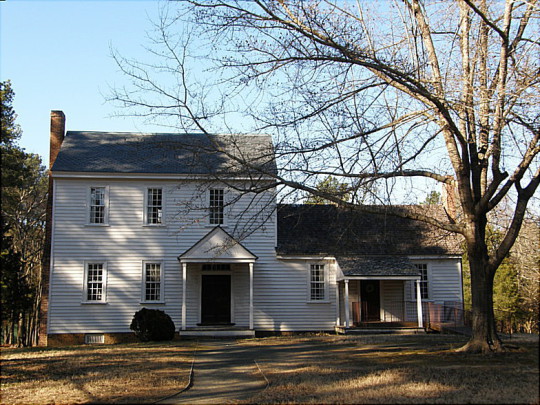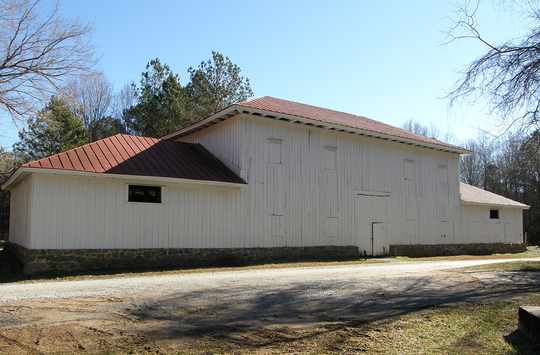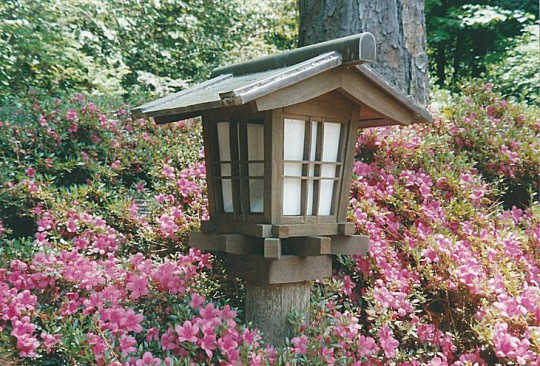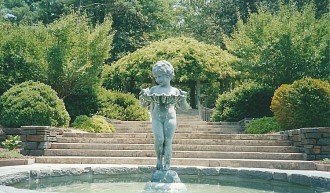DURHAM COUNTY
Scroll down this page or click on specific site name to view features on the following Durham County attractions/points of interest:
Bennett House State Historic Site, Duke Homestead State Historic Site, Duke Lemur Center, Historic Stagville State Historic Site, Museum of Life and Science, Sarah P. Duke Gardens
Fast facts about Durham County:
Created in 1881, the county is named for Dr. Bartlett Snipes Durham.
The county seat is Durham. Other communities include Bahama, Oak Grove, and Rougemont.
Durham County’s land area is 290.32 square miles; the population in the 2010 census was 267,587.
It is worth noting that, near Durham Station on April 26, 1865, Confederate General Joseph E. Johnston surrendered troops under his command throughout the southeast to Union General William T. Sherman, effectively ending the American Civil War. Duke University is located in Durham.
Durham
The Bennett House State Historic Site in Durham preserves the site where Confederate General Joseph E. Johnston surrendered his forces to Federal General William T. Sherman on April 26, 1865. When news of General Lee’s surrender at Appomattox reached Confederate General Joseph E. Johnston, he and his troops were encamped in the vicinity of Hillsborough, North Carolina. At the same time, Sherman’s Federal army occupied Raleigh. Jefferson Davis and his cabinet, having fled Richmond, were hastily traveling through North Carolina to escape capture. They meet with Johnston in Greensboro on April 12 and 13. As a result of these meetings, Johnston was given permission to initiate peace talks with Sherman. The first meeting between the two commanders, arranged by subordinates, was held April 17 at Durham Station, a point roughly midway between Hillsborough and Raleigh. At Johnston’s suggestion, the generals agreed to talk matters over at a small farmhouse Johnston had passed en route, the home of James Bennett.
At a subsequent meeting held at the Bennett farm the following day, one that was also attended by Confed-erate Secretary of War John C. Breck-inridge, conditions for surrender were drafted. Although these terms were reluctantly agreed to by President Davis, who was by this time in Charlotte, they were dismissed by President Andrew Johnson. Grant personally met with Sherman to tell him that the terms had been rejected and to give him additional instructions. As a result, another meeting between Sherman and Johnston took place at the Bennett house on April 26, and new terms were agreed upon. Johnston’s signature on the revised agreement meant the surrender of nearly 90,000 troops spread across North and South Carolina, Georgia, and Florida, more than three times the number of soldiers Lee had under his command at Appomattox.
After the war, the Bennett family continued to work the farm until the late 1880s, when the property was sold. The farm lay idle for more than three decades. In the early 1920s, the home site and 3-½ acres were donated to the state on condition that a monument would be erected on the grounds to commemorate the events which occurred here. Unfortunately, in 1921, the house was destroyed by a fire thought to have been started inadvertently by itinerants. Shortly thereafter, the NC General Assembly established a memorial commission responsible for maintaining the property. In 1923, the Unity Monument was erected, symbolizing the coming together of North and South. In the early 1960s, a Durham house very similar in age, size, and layout to the original Bennett house was relocated to the property. Bennett Place was established as a state historic site in 1961, and the restored house and replica kitchen were dedicated in 1962. A period smoke house was placed on the grounds in 1963, and in 1982, a modern visitor center opened.
A visit to the site today includes a guided tour of the house and kitchen and a stop at the Unity Monument. The visitor center includes an audiovisual program entitled “Dawn of Peace,” and a small gallery contains exhibits detailing North Carolina’s role in the Civil War, her many contributions to the Confederate cause, and various artifacts from the conflict. “Costumed Saturdays” are featured all summer long. On the weekend nearest the anniversary of the surrender, special programs and activities are featured. Other events are scheduled seasonally. From I-85 in Durham, take exit 173 and turn onto Cole Mill Road. Go ½ mile and turn right onto Hillsborough Road, then bear left onto Neal Road. Bennett Memorial Road is ¼ mile on the left. Hours are 10-4 Tuesday-Saturday. Closed Sunday, Monday, and major holidays. Admission is free. 919-383-4345
Durham
The Duke Homestead State Historic Site in Durham is one of the most important stops along North Carolina’s famed “Tobacco Road." A visit will yield much more than the story of bright leaf tobacco and North Carolina’s “green gold.” It will reveal how hard work and entrepreneurial skills transformed a yeomen farmer and his sons into one of the wealthiest families in America.
Washington Duke, unwillingly drafted into the Confederate Army in late 1863, returned to his small farm in Durham County at war’s end to resume the life he had left behind. Just before the outbreak of hostilities, Duke had begun planting tobacco as a cash crop. With the help of sons Brodie, Benjamin, and James, Duke picked up where he left off, raising and harvesting a crop of bright leaf tobacco – so called because of its golden color when cured – a variety that found favor among soldiers from both North and South during the war years. The Dukes built a small log factory within sight of their farmhouse and began successfully marketing their product in sacks tagged with a label reading “Pro Bono Publico” – “for the public good.”
The product was well received, and Wash-ington Duke built two larger factories on the farm in quick suc-cession. In 1869, Brodie Duke opened up a factory of his own in Durham, where rail transporta-tion and warehousing facilities helped the business grow even faster. In 1874, the entire family was back together in yet another Durham facility. The family’s real success, however, came in 1884, when the Dukes started manufacturing cigarettes on a machine invented by James Albert Bonsack. A competitor in Richmond, Virginia had used the invention earlier, but frequent equipment breakdowns prompted its removal. The Dukes overcame these problems and in so doing gave themselves an incredible advantage over the competition. Whereas even the most skilled factory worker could only roll four to five cigarettes a minute by hand, Bonsack’s cigarette roller produced 120,000 a day!
In 1890, W. Duke, Sons and Company merged with four other large tobacco producers to form The American Tobacco Company. In 1911, before the passage of the Sherman Anti-Trust Act caused its break-up, the company controlled the growing, purchasing, warehousing, manufacturing, marketing, and distribution of nearly 90% of the tobacco market. The four companies created when the tobacco trust was broken became equally well known in North Carolina in the years that followed: the new American Tobacco Company, Liggett and Myers, P. Lorillard, and R. J. Reynolds.
The Duke Homestead became a state historic site in the 1970s. The visitor center features a video entitled “Bright Leaf” that explains what makes this leaf different from other types of tobacco. The center’s museum traces the history of the plant from its earliest use by American Indians to the present. Guided tours of the homestead last about an hour and include stops at a packhouse, smokehouse, and curing barn, as well as the Duke’s third factory. The tour concludes at the simple, two-story frame farmhouse built in 1852, where the focus shifts from tobacco to the Duke family, and what life was like on a typical North Carolina farm during the 1870s. From I-85 in Durham, take Exit 175. Drive one mile north, then turn right onto Duke Homestead Road. Hours are 10:00-4:00 Tuesday-Saturday. Closed Sunday and Monday. Admission is free. 919-477-5498
Durham
What could be more fun than a barrel of monkeys? How about an 85-acre educational center devoted almost exclusively to lemurs, the forerunners of today’s apes and monkeys? These aren’t just your ordinary, jungle-variety primates. Rather, the Duke Lemur Center in Durham is home to three very specific groups of prosimians: the lemurs of Madagascar, the galagos (“bushbabies”) of Africa, and the lorises of Asia. The published mission statement of the Duke Lemur Center is to “promote research and understanding of prosimians and their natural habitat as a means of advancing the frontiers of knowledge, to contribute to the educational development of future leaders in international scholarship and conservation, and to enhance the human condition by stimulating intellectual growth and sustaining global biodiversity.” This might sound a bit dull, but a visit to the Center is anything but. Begun in 1966 as the Duke University Primate Center, the facility has since changed its name and has become the largest sanctuary in the world for rare and endangered prosimians primates. The research center is located within the confines of Duke Forest and houses more than 200 lemurs representing 15 species, as well as African bushbabies and Asian lorises. These prosimians are considered “living fossils” by researchers, who study all aspects of the animals’ lives, including diet, social behavior, grooming, vocal communication, use of hands, adaptive abilities, and genetics. Among the more interesting discoveries about these acrobatic, inquisitive, and playful animals is that the individual social groups, which number between 3-16 lemurs, are led by a dominant female.
Standard tours last about an hour and begin with a 10-minute introductory video. Visitors see about three dozen animals during their walk around the compound. Perhaps the most easily-recognized residents are the ring-tailed lemurs, with their gray bodies, white faces, black eye patches, and long black-and-white tails. The most colorful might be the golden bamboo lemur, with blonde arms and legs. The Aye-Aye, frankly, has a face only a mother could love. A pop-eyed loner with buck teeth and long fingers, the Aye-Aye lives in the nocturnal building. Other residents of the nocturnal building are the fat-tailed dwarf lemur, which can store up to 40% of its body weight in its tail to help it survive during long non-vegetative periods; lorises, with fixed eyes and no tails; and the diminutive mouse lemurs. From mid-May to the end of September, it is possible to arrange for special, personalized tours of the 60-acre enclosure; visitors must be 11 or older. Enclosure tours last 1-½ to 2 hours and visit six areas. Here, lemurs will be seen roaming freely in something approximating their natural environments. Free of cages, the curious lemurs will often come within just a few feet of guests, allowing for unobstructed viewing and wonderful photo opportunities.
The Duke Lemur Center is open for pre-arranged tours only Monday through Saturday. “Drop-in” visits are not permitted. It is suggested that tours be scheduled at least two weeks in advance of the date you wish to visit. Admission charged. The cost for the special, personalized tours is $100 for one to four people; a fifth or sixth person can be added for $25 each. To schedule a tour, call 919-489-3364, extension 0. A gift shop is open during regular hours Monday-Saturday. All money collected from tours and the sale of merchandise goes directly to the operation of the Center. To get to the Center, take US 15/501 to NC 751. Turn right at the bottom of the ramp. At the traffic circle, go ¾-way around and veer onto Erwin Road. Take the first left onto Lemur Lane – disregard the signs saying “Restricted.” Follow the lane until it ends, turning right onto a gravel road and continuing through the gate to the gravel parking lot on the left. Check in at Lemur Landing.
Durham
Historic Stagville, preserved as a North Carolina historic site, was the center of one of the largest antebellum plantations in the state at the outbreak of the Civil War. Virginia merchant Richard Bennehan first moved to North Carolina in 1768 at the age of 25. He purchased a one-third share in a general store owned by William Johnston. The Little River Store was located on a well-traveled route, business was good, and Bennehan’s investment reaped profits. In 1776, the same year he wed Mary Amis of Northampton County, Bennehan purchased farmland from Judith Stag and was able to begin his own plantation. In 1787, he built a one-and-a-half story farmhouse; in 1799, he more than doubled the size of his home by adding a two-story addition. Although far from ostentatious, the vernacular, Georgian-style plantation house was nevertheless comfortable and spacious for the time and place. Over time, Bennehan became one of the wealthiest planters in the region, owning 4,000 acres and 40 slaves, and raising livestock, tobacco, and grain. Among Bennehan’s friends and acquaintances were such notable North Carolina individuals as William R. Davie, David Swain, Archibald Murphey, and James Iredell.
The Bennehans had two children, Thomas and Rebecca. Thomas remained a bachelor throughout his life and Stagville was his only home; Rebecca married Duncan Cameron, a Hillsborough lawyer, in 1803. In 1807, the couple moved to Stagville and Duncan assisted in operating the combined Bennehan-Cameron plantations. Under Duncan’s management, the plantations continued to thrive. In time, the Cameron’s third child, Paul, assumed management of the sprawling plantations. A civic-minded individual, Paul Cameron also served as president of the North Carolina Railroad, state senator, and University trustee. At the start of the Civil War, the plantation holdings of the Bennehan-Cameron families totaled nearly 30,000 acres and 900 slaves, and Paul Cameron was considered the wealthiest man in the state.
A guided tour of the site begins with the late 18th century plantation house. The original portion of the house, circa 1787, includes a business office, dining room, butler’s pantry (formerly a bedroom), and second floor loft. The 1799 addition includes an entry hall and parlor on the first floor and two bedrooms on the second. The house was built of heart pine, and all of the interior woodwork is original. Although the house has minimal furnishings, one exceptionally fine piece on display is a dresser attributed to Thomas Day. Other buildings on the tour are located about a mile away. In an area called Horton Grove, visitors will see four two-story slave quarters built during the 1850s. Each building includes four rooms, with each room intended to house 5 to 7 people. In an effort to improve the health of the slaves, the houses were raised up on foundations to improve ventilation. In addition, they had brick nogging to prevent drafts, retain heat, and keep out rodents. The buildings had vertical board and batten siding, and interior walls were white washed. Built by slave labor, the craftsmanship displayed in these buildings is evidence that many skilled artisans worked the Stagville plantation. This fact is further underscored by a visit to the Great Barn. Likewise built by slave labor, it was possibly the largest agricultural building in North Carolina upon its completion in 1860. Measuring 132 feet by 33 feet, Paul Cameron described it as the “best stable” ever built in Orange County. Used to shelter 70 to 75 mules, the Great Barn was Stagville’s last major improvement and testifies to the family’s prosperity and the skills of the enslaved craftsmen. To get to Stagville from Durham, take Roxboro Road/Business north. Turn right onto Old Oxford Highway and continue approximately seven miles. Stagville is on the right. Hours are 10-4 Tuesday-Saturday. Tours are given on the hour beginning at 10; the last tour begins at 3. Admission is free. 919-620-0120
Durham
Short of a full-scale theme park, it would be hard to find an attraction more likely to satisfy children more than the Museum of Life and Science in Durham. To be certain, there are many things to interest adults as well, but the main focus is on the kids. For inquisitive youngsters, the Museum is a day-long, indoor-outdoor adventure. Plan on doing a lot of walking!
The Museum of Life and Science is comprised of spacious indoor galleries and several outdoor exhibits. The main museum has many hands-on activities to engage the curiosity of children about weather and daily science. The Carolina Wildlife exhibit showcases owls, alligators, snakes, turtles, and other critters common to the Tar Heel State. Children and adults alike will find many interesting objects in the Aerospace gallery, among them the Mercury-Atlas 5 capsule. On November 29, 1961, this spacecraft carried a chimpanzee named Enos into space for a two-orbit flight lasting 3 hours and 21 minutes. This was the final test before John Glenn’s historic orbital flight only three months later in a similar Mercury capsule. The focal point of the gallery is the mock up of the Apollo 15 Lunar Lander. In 1971, Commander David Scott and lunar module pilot James Irwin spent 67 hours on the moon’s surface in a craft of this type. Scott and Irwin collected 171 pounds of lunar samples, and an actual moon rock collected by Commander Scott (lunar sample15459) is on display at the museum; the stone weighs 3.2 oz and is 3.9 billion years old.
Outside attractions begin at Loblolly Park, where kids can have fun banging drums, clanging chimes, climbing on board a caboose, or playing in the sand box or tree house. Next up is the Farmyard, populated by sheep, goats, pigs, roosters, turkeys, and other animals one might expect to find on Old MacDonald’s farm. The Ellerbee Creek Railway is a kid-sized train ride that winds its way through the heavily-wooded northwestern perimeter of the Museum complex. [With limited seating, this ride often sells out early on weekends. Tickets can be purchased at the Admissions Desk.] The “Explore the Wild” exhibit includes a wetland habitat and separate compounds for bears, wolves, and lemurs. In the “Catch the Wind” section, kids can pilot radio-controlled sailboats and “fly” a DaVinci-inspired ornithopter. And mammoth amounts of adventurous fun will be had along “Dinosaur Trail,” featuring life-like, state-of-the art models of late-cretaceous dinosaurs.
The Magic Wings Butterfly House features a tropical conservatory where hundreds of butterflies flit their way aimlessly about. Temperature in the conservatory is a constant 80 degrees, with 80% humidity, ideal conditions for the “spineless wonders” that thrive in moist tropical climates. In another area of the Butterfly House is the Insectarium. Kids squeal and adults squirm as they experience close encounters with the cockroaches, beetles, grasshoppers, and other six-legged bugs. Despite the name, not all the residents in this exhibit are insects. Tarantulas, scorpions, millipedes, and poison dart frogs are on hand as well. Museum hours are 10-5 Tuesday through Saturday and 12-5 Sunday. Closed Mondays. Admission charged. There is a small additional charge for the train ride. Strollers can be rented for a nominal fee. Grayson’s Café offers a varied menu; hours are 11-4 Tuesday-Saturday and 12-4 Sunday. 919-220-5429
Durham
Those who think there is nothing quite as pleasant as a relaxing stroll through a garden will find the Sarah P. Duke Gardens in Durham a highly-satisfying destination. Covering 55 acres in the heart of Duke University’s West Campus, the Gardens are considered one of the best in the nation, attracting more than 300,000 visitors annually.
In the early 1930s, Dr. Frederic M. Hanes of the Duke Medical School faculty wanted to turn a debris-filled ravine – a campus eyesore he walked by every day – into something a little more pleasing to the senses. As someone who enjoyed plants and flowers, he convinced Sarah P. Duke, widow of Benjamin N. Duke, one of the University’s founders, to give $20,000 to finance the construction of a garden. In 1935, thousands and thousands of irises, daffodils, and assorted annuals were growing in more than one hundred flower beds in an area referred to today as the South Lawn. Heavy summer rains, however, washed away the flowers and, along with them, all the money and hard work that had gone into their planting. At the time of Sarah Duke’s death in 1936, the original gardens were in shambles. Dr. Hanes successfully convinced Mrs. Duke’s daughter, Mary Duke Biddle, to finance construction of a new garden, on higher ground, as a memorial to her mother. Ellen Shipman, a popular landscape designer among the wealthy, was chosen to do the design and planting for the new gardens. The Sarah P. Duke Gardens are the only public gardens Shipman designed and are considered her greatest work.
Five miles of avenues, walks, and shaded pathways wind their way through four major areas. The original portion, and undoubtedly the most popular, is the Terraces. A central stairway descending a gently-sloping hillside is punctuated by two fountains and is flanked on either side by carefully manicured flower beds. At the bottom of the hill is a fish pond. Beyond it, and in striking contrast to the precise arrangement of the terraces, is a rock garden, cleverly designed to suggest an alpine meadow. Visitors can enjoy a panoramic view of the terraces, pond, and rock garden from the vantage point of a wisteria-covered pergola that overlooks the idyllic setting.
The second section of the gardens is the 6.5-acre Blomquist Garden of Native Plants. Named for Professor Hugo L. Blomquist, founder of Duke University’s Department of Botany, this heavily-wooded area contains over 900 species and varieties of native regional plants. The Blomquist Pavilion garden shelter is the focal point of this section. Located at the eastern end of the garden, it is situated next to a small pod traversed by old-fashioned milestones.
The third section, covering 20 acres, is the Culberson Asiatic Arboretum. Begun in 1984, the arboretum demonstrates the close relationship between the flora of eastern Asia and eastern North America. Points of interest include the Yatsuhashi (Zig-Zag) Bridge, the Teien-oike Garden Pond, the teahouse shelter, and the picturesque Iris foot bridge. Last but not least are the small gardens located behind the Doris Duke Center, an impressive multipurpose structure completed in 2001 and designed to be completely harmonious with its surroundings. The Gardens are open daily from 8 AM to dusk. The Doris Duke Center is open 9-6 Monday-Saturday and 12-5 Sunday. Closed major holidays. Admission is free. 919-684-3698
Durham County is bordered by CHATHAM, GRANVILLE, ORANGE, PERSON, and WAKE counties.
Return to REGION FOUR HOME PAGE.
Return to GEOGRAPHIC REGIONS HOME PAGE.

